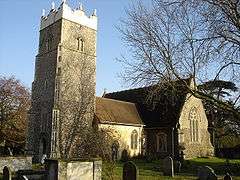St Peter's Church, Claydon
| St Peter's Church, Claydon | |
|---|---|
 St Peter's Church, Claydon, from the southwest | |
 St Peter's Church, Claydon Location in Suffolk | |
| Coordinates: 52°06′20″N 1°07′10″E / 52.1056°N 1.1195°E | |
| OS grid reference | NZ 274 513 |
| Location | Claydon, Suffolk |
| Country | England |
| Denomination | Anglican |
| Website | Churches Conservation Trust |
| History | |
| Dedication | Saint Peter |
| Architecture | |
| Functional status | Redundant |
| Heritage designation | Grade I |
| Designated | 9 December 1955 |
| Architect(s) | Richard M. Phipson (restoration) |
| Architectural type | Church |
| Style | Anglo-Saxon, Gothic, Gothic Revival |
| Completed | 1852 |
| Closed | 1977 |
| Specifications | |
| Materials |
Flint with limestone dressings Tiled roofs |
St Peter's Church is a redundant Anglican church in Claydon, Suffolk, England. It is recorded in the National Heritage List for England as a designated Grade I listed building,[1] and is under the care of the Churches Conservation Trust.[2] It stands in a position overlooking the Gipping valley.[2]
History
The earliest fabric in the church is in the nave; this dates from the 11th century. The east window is from the 14th century, and the tower was added in the 15th century. Also around this time the north porch was built and doorways and windows in the nave were replaced. A major restoration was carried out in 1852. This was under the direction of the High Church rector at the time, Rev George Drury, working with the architect Richard M. Phipson. Prior to this, the church had consisted of a nave, a chancel, a west tower and a north porch. As part of the restoration, the chancel was virtually rebuilt, and transepts and organ chambers were added. Much of the joinery of the transept roofs and fittings was carried out by Henry Ringham. It is thought that some of the stained glass in the east window was designed by Rev Drury.[1] The church was declared redundant in 1977 but it was not vested in the Churches Conservation Trust until eleven years later.[3]
Architecture
The church is constructed in flint, parts of which have been rendered, with limestone dressings. The roofs are tiled. Its plan consists of a short nave with a north porch, north and south transepts, a chancel, a vestry, and a west tower. The nave is Anglo-Saxon in style, with long-and-short quoins at the western corners. The tower is Perpendicular, and the parts restored in the 19th century are in Decorated style. The tower has a battlemented parapet on which stand seven limestone statues; there were originally eight, but one is missing. It is supported by buttresses decorated with flushwork. The nave contains moulded north and south doorways. The rear arch in the south doorway is round-headed. The nave roof is in three bays. The transept roofs contain carved bosses. The octagonal limestone font dates from about 1400. The rest of the fittings date from the 19th-century restoration. These include the pulpit with its elaborate pierced tracery.[1] The two-manual organ was built in 1863 by Bevington.[4]
See also
References
- 1 2 3 Historic England, "Church of St Peter, Claydon (1250925)", National Heritage List for England, retrieved 10 April 2015
- 1 2 St Peter's Church, Claydon, Suffolk, Churches Conservation Trust, retrieved 1 December 2016
- ↑ Knott, Simon (2007), St Peter, Claydon, The Suffolk Churches Site, retrieved 8 December 2010
- ↑ Suffolk, Claydon, St. Peter (D05564), British Institute of Organ Studies, retrieved 8 December 2010